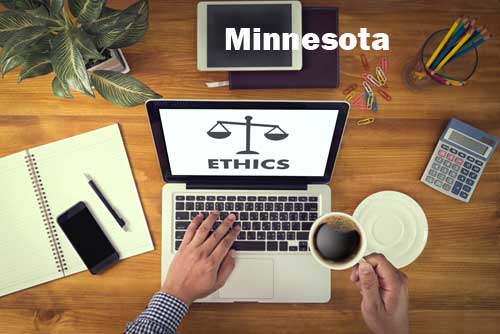In the architecture, engineering, and design fields, rules and laws play a crucial role in ensuring the safety, functionality, and aesthetics of structures and spaces. Professionals in Minnesota, including architects, engineers, land surveyors, geologists, landscape architects, soil scientists, and interior designers, are bound by specific regulations that govern their practice. Understanding and complying with these rules and laws is essential for maintaining professional standards and protecting the public interest. In this article, we will delve into Minnesota Ethics, Rules and Laws for Professionals. Exploring licensing requirements, code of ethics, practice acts, liability and accountability, contractual obligations, building codes, environmental considerations, emerging trends and technologies, collaboration, continuing education, and more.
Professionals! Get your continuing education pdh course Minnesota Ethics, Rules and Laws for Engineers to renew your PE license.
Licensing Requirements
To practice as an architect, engineer, land surveyor, geologist, landscape architect, soil scientist, or interior designer in Minnesota, individuals must meet specific licensing requirements. These requirements typically include a combination of education, experience, and examinations. Aspiring professionals must complete accredited programs, gain practical experience under the supervision of licensed practitioners, and pass licensing exams. Additionally, continuing education is often necessary to maintain licensure and stay updated with industry advancements.
Code of Ethics
Professional ethics are of utmost importance in maintaining the integrity and reputation of the architecture, engineering, and design professions. In Minnesota, each of these professions has its own code of ethics that outlines the principles and standards professionals must adhere to. These codes emphasize honesty, integrity, competence, confidentiality, and the responsibility to prioritize public welfare and safety. By adhering to these ethical guidelines, professionals can build trust with clients and ensure their work aligns with the highest standards of professionalism.
Practice Act
Minnesota’s Practice Act for architects, engineers, land surveyors, geologists, landscape architects, soil scientists, and interior designers defines the scope of practice for each profession. It outlines the specific activities professionals are authorized to perform and those that are prohibited. Understanding the limitations and responsibilities outlined in the Practice Act is crucial to avoid potential legal and professional consequences. By adhering to these regulations, professionals can provide services within their expertise and protect the public from unqualified practitioners.
Professional Liability and Accountability
Professional liability insurance is essential for architects, engineers, and other professionals to protect themselves and their clients from financial losses arising from errors, omissions, or negligence. Minnesota also has disciplinary actions in place for professionals who violate rules and laws. Complaints against professionals can lead to investigations, hearings, and potential sanctions if violations are proven. This accountability ensures that professionals maintain high standards and act responsibly in their practice.
Contractual Obligations and Responsibilities
When working with clients, architects, engineers, and other professionals enter into contractual agreements that define their obligations and responsibilities. These contracts establish the scope of work, timelines, payment terms, and dispute resolution mechanisms. Understanding the legal aspects of contracts is crucial to protect both the professional and the client’s interests. By clearly defining expectations and responsibilities, professionals can establish positive working relationships and minimize conflicts.
Building Codes and Regulations
Ensuring compliance with building codes and regulations is a primary responsibility of architects, engineers, and other professionals involved in construction projects. These codes, established by local and state authorities, provide guidelines for structural integrity, fire safety, accessibility, energy efficiency, and more. Professionals must stay up to date with the latest codes and regulations to design and construct buildings that meet the required standards. Building permits and inspections are also essential to ensure compliance throughout the construction process.
Environmental Considerations
With increasing concerns about sustainability and environmental impact, architects, engineers, and designers are incorporating environmentally friendly practices into their work. Minnesota has specific regulations and certifications related to sustainable design and construction. Professionals play a vital role in minimizing the environmental footprint of buildings and spaces by integrating energy-efficient systems, using sustainable materials, and designing for resource conservation. By prioritizing environmental considerations, professionals contribute to a greener and more sustainable future.
Emerging Trends and Technologies
Technology is revolutionizing the architecture, engineering, and design industries. From building information modeling (BIM) to virtual reality (VR) and 3D printing, professionals have access to innovative tools that enhance their design process, collaboration, and project management. This section will explore the latest trends and technologies that professionals in Minnesota are embracing. The integration of digital tools and software allows for more efficient workflows, improved communication, and enhanced visualization, leading to better project outcomes.
Collaboration and Interdisciplinary Work
In today’s complex projects, collaboration between professionals from different disciplines is crucial for success. Architects, engineers, land surveyors, geologists, landscape architects, soil scientists, and interior designers often work together to create integrated and holistic solutions. Effective communication, coordination, and the ability to work as part of interdisciplinary teams are essential skills for professionals in Minnesota. By leveraging the expertise of various disciplines, professionals can deliver projects that meet diverse client needs and achieve outstanding results.
Continuing Education and Professional Development
Staying updated with industry advancements and acquiring new knowledge and skills is essential for professionals to thrive in their careers. Continuing education requirements are in place in Minnesota to ensure professionals engage in lifelong learning. By attending workshops, seminars, conferences, and obtaining additional certifications, professionals can expand their expertise. They also stay abreast of emerging trends, and provide clients with the most innovative solutions. Professional organizations and resources offer valuable opportunities for networking, mentoring, and ongoing professional development.
Case Studies and Success Stories
Highlighting notable projects and success stories by professionals in Minnesota provides real-life examples of the impact these professionals have on the built environment. Case studies showcase innovative designs, sustainable practices, and creative solutions to challenges. By analyzing successful projects, readers can gain valuable insights, learn from best practices, and draw inspiration for their own work.
Future Outlook
The architecture, engineering, and design industries are constantly evolving. This section will explore the future outlook for these professions in Minnesota, considering technological advancements, changing regulations, and emerging trends. Anticipated developments and challenges will be discussed, providing professionals and aspiring practitioners with a glimpse into what lies ahead. By understanding the future landscape, professionals can proactively adapt, embrace new opportunities, and contribute to the growth and evolution of their respective fields.
Conclusion
Minnesota Ethics Rules and Laws for Professionals are designed to ensure the highest standards of professionalism, ethics, and public safety. Compliance with licensing requirements, codes of ethics, practice acts, and building regulations is vital for professionals to maintain their credibility and protect the welfare of their clients. By staying updated with industry advancements, embracing emerging technologies, and fostering collaboration, professionals can thrive in their careers and contribute to the sustainable development of Minnesota’s built environment.
FAQs
-
Are architects, engineers, land surveyors, geologists, landscape architects, soil scientists, and interior designers required to have a license in Minnesota?
Yes, in Minnesota, architects, engineers, land surveyors, geologists, landscape architects, soil scientists, and interior designers are required to have a license to practice their respective professions. Licensing ensures that professionals have met the necessary educational and experience requirements and have demonstrated competency in their fields.
-
What are the educational requirements to become a licensed architect in Minnesota?
To become a licensed architect in Minnesota, individuals must complete a professional degree in architecture from an accredited program. The degree can be a Bachelor of Architecture (B.Arch) or a Master of Architecture (M.Arch). In addition to the degree, candidates must also fulfill the National Council of Architectural Registration Boards (NCARB) experience requirement, which typically involves completing a specific number of internships under the supervision of a licensed architect.
-
Can an engineer practice architecture or vice versa in Minnesota?
No, in Minnesota, the practice of architecture and engineering are distinct and separate professions with their own licensing requirements. Architects design buildings and focus on the aesthetic and functional aspects of structures. Engineers, on the other hand, specialize in the analysis and design of the technical systems within buildings. While there may be some overlap in the skills and knowledge of architects and engineers, professionals must be licensed in their specific field to practice legally in Minnesota.
-
How can professionals in these fields maintain their licenses in Minnesota?
To maintain their licenses in Minnesota, professionals must fulfill certain requirements. This typically includes completing a specified number of continuing education hours within a specific time period. Continuing education ensures that professionals stay updated with the latest developments, technologies, and regulations in their respective fields. By participating in workshops, seminars, courses, and conferences, professionals can enhance their knowledge and skills while fulfilling the licensing requirements.
-
What disciplinary actions can be taken against professionals who violate rules and laws in Minnesota?
In Minnesota, disciplinary actions can be taken against professionals who violate the rules and laws governing their respective professions. The specific actions may vary depending on the nature and severity of the violation. Possible disciplinary measures include reprimands, fines, probation, suspension, or revocation of the professional’s license. The disciplinary process typically involves an investigation, a hearing, and a decision by the relevant licensing board or authority. These measures are in place to maintain the integrity of the professions, protect the public, and ensure that professionals adhere to ethical and legal standards.


